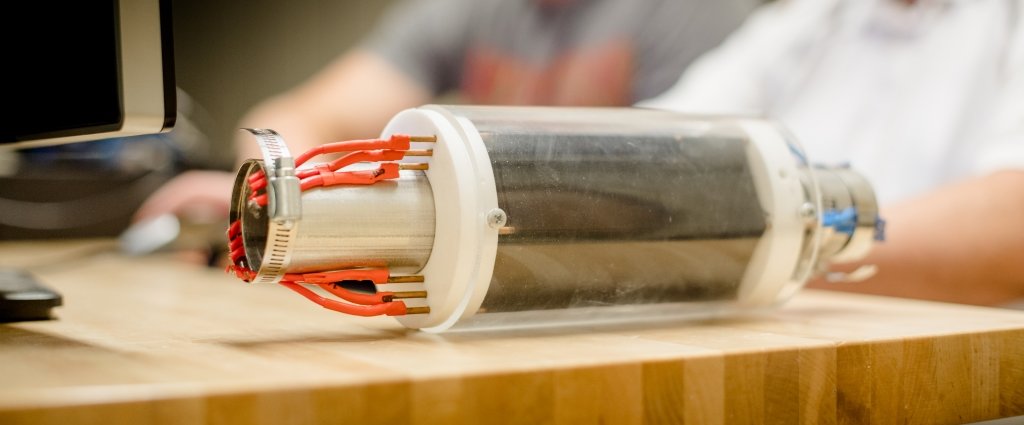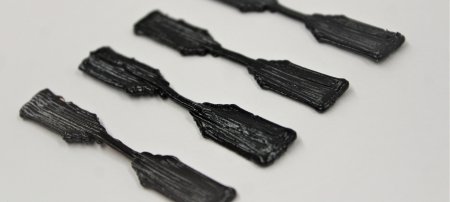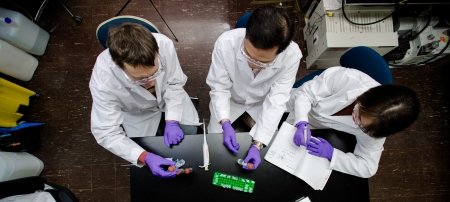How do you muffle the roar of a big, industrial heating, ventilation and air conditioning (HVAC) system using safe, compact, inexpensive technology? With coaxial thermophones.
First there was the technical problem: developing technology to keep an industrial HVAC system quiet. Then came the next challenge: commercializing the technology.
Andrew Barnard, assistant professor of mechanical engineering, and his graduate student, Steven Senczyszyn, who earned his master’s degree in May and is now a research engineer in mechanical engineering, joined forces with Great Lakes Sound & Vibration to solve the first problem. They created an active noise control system, which works by playing back the opposite of the sound you are trying to cancel.
“This is how noise canceling headphones work,” Senczyszyn says. “They measure the incoming sound and use a speaker to play back the opposite of that sound, which effectively eliminates the incoming sound before it reaches your ears.”
The goal of Barnard and Senczyszyn’s technology is to do the same thing inside HVAC ducts using coaxial thermophones. A thermophone is a type of loudspeaker that generates sound using heat. Coaxial means that two items share a common axis, so a coaxial loudspeaker fits directly in-line with a duct without obstructing airflow in the duct. They’re made of carbon nanotubes that are extremely tiny tubes of carbon—less than 1/1000th the diameter of a strand of human hair.

“A carbon nanotube forest consists of millions of these small tubes, standing up and aligned with each other,” Senczyszyn explains. “When we pull on one end of these forests, the tubes fall together, creating a film we can wrap to create our speakers.”
Having created and tested their technology, Barnard and Senczyszyn faced another, equally challenging problem: how to scale it up and ready it for the marketplace.
NSF Grant to Commercialize New Technology
They have just received a $200,000 grant from the National Science Foundation’s (NSF) Partnerships for Innovation-Technology Translation program to tackle that challenge. They will use the 18-month grant to develop a prototype, form a business, demo the technology to the HVAC market at trade shows and conferences and disseminate data in trade publications.
The goal is to use their prior research on carbon nanotube thermophones—originally designed to muffle automotive noise—coupled with customer feedback from a market study by an NSF-funded I-Corps team, to design and prototype a coaxial active noise control device for the HVAC industry. The research is a prime example of the work done here on Innovation Shore.
Carbon nanotube thin films, with their low-heat capacity properties, have opened the door for an evolutionary change in loudspeaker technology, the acoustic engineering researchers say in their NSF project description.
This technology provides a significant reduction in both the size and weight of the system used to control the noise generated by an air handling unit, as well as improved performance of the HVAC system, due to the coaxial design, Senczyszyn says.
“The size and weight reduction makes it much easier to design into new buildings, and it is a great option for retrofitting older buildings with noise problems,” he says. “The improved performance of the air handler provided by the coaxial design has the potential to save on operating costs as well as extend the life of the air handler.”

Smaller, Safer Sound Control
The technology is also safer. Without the need for fibrous materials acting as sound absorbers—materials that break down over time and can enter the air ducts—the new technology can be used by hospitals, where conventional silencers can pose a threat to patients, Barnard and Senczyszyn explain in their project proposal. They can control low frequency noise while taking up 90 percent less space. They can also adapt to changing sound sources, which conventional silencers can’t. The new technology will be valuable not only to hospitals, but to schools and residents in industrial areas as well.
“Noise has a known negative effect on student learning,” Barnard explains. “And community noise in industrial areas can cause sleep interruption and increased stress on residents.”
Meeting the Next Challenges
There are still significant technical problems to solve. One is increasing the scale of a demonstration model. Another is long-term durability. And a third, is identifying a material for the diaphragm that protects the carbon nanotube thermophone from airflow in the duct.
There are also business issues. Steve Tokarz, Michigan Tech’s mentor-in-residence, will advise the team on the commercialization and product development. A patent on the new technology is pending.
Barnard and Senczyszyn are convinced that they can overcome these hurdles.
"This project is significant because it will help us commercialize our technology,” says Barnard. “Many university technologies die in the laboratory because there is no connection made between the technology advancements and the customer.”
He explains the NSF grant will enable the team to develop a demonstrator unit that will be used to pitch the technology to business partners, investors and customers.
“We have talked to almost 200 people through our customer discovery process to help us define the value that our minimum viable product must offer,” Barnard says. “Only by matching the product value proposition to the customer needs can we launch a successful product."
The new grant will help Barnard and Senczyszyn both quiet HVAC systems with carbon nanotubes, and make more noise about their technology as they develop and commercialize their coaxial thermophones.

Michigan Technological University is an R1 public research university founded in 1885 in Houghton, and is home to nearly 7,500 students from more than 60 countries around the world. Consistently ranked among the best universities in the country for return on investment, Michigan's flagship technological university offers more than 120 undergraduate and graduate degree programs in science and technology, engineering, computing, forestry, business, health professions, humanities, mathematics, social sciences, and the arts. The rural campus is situated just miles from Lake Superior in Michigan's Upper Peninsula, offering year-round opportunities for outdoor adventure.






Comments